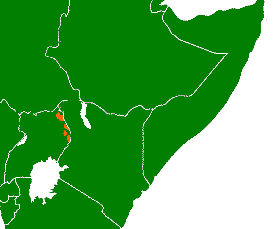Kuliak languages
| Kuliak | |
|---|---|
| Rub | |
| Geographic distribution | northeast Uganda |
| Linguistic classification |
|
| Glottolog | kuli1252[1] |
 | |
The Kuliak languages are a group of languages spoken by small relict communities in the mountains of northeastern Uganda. Bender (1989) had classified them within the Eastern Sudanic languages, but by Bender (2000) he had separated them out as a peripheral isolate within Nilo-Saharan. Significant influence from Cushitic languages, and more recently Nilotic languages, is observable in the vocabulary and phonology. Bernd Heine proposed a reconstruction of Proto-Kuliak. Soo and Nyang'i form a subgroup, Western Kuliak, against Ik. Blench notes that Kuliak appears to retain a core of non-Nilo-Saharan vocabulary, suggesting language shift from an indigenous language like that seen in Dahalo.
Nyang'i is close to extinct (there is one remaining speaker with reasonable fluency), and Soo is moribund. However, Ik is vigorous, and growing.
- Internal classification
| Kuliak |
| ||||||||||||
References
- ↑ Hammarström, Harald; Forkel, Robert; Haspelmath, Martin; Bank, Sebastian, eds. (2016). "Kuliak". Glottolog 2.7. Jena: Max Planck Institute for the Science of Human History.
- Heine, Bernd (1976) The Kuliak Languages of Eastern Uganda. Nairobi: East African Publishing House.
- Laughlin, C. D. (1975) "Lexicostatistics and the mystery of So ethnolinguistic relations" in Anthropological Linguistics 17:325-41.
- Fleming, Harold C. (1982) "Kuliak external relations: step one" in Nilotic Studes (Proceedings of the international symposium on languages and history of the Nilotic Peoples, Cologne, January 4–6, 1982, Vol 2, 423–478.
- Blench, Roger M. (2006) Archaeology, Language and the African Past . Lanham: Altamira Press.